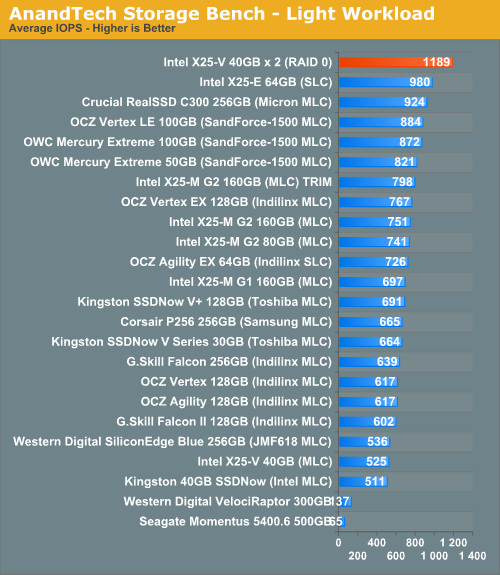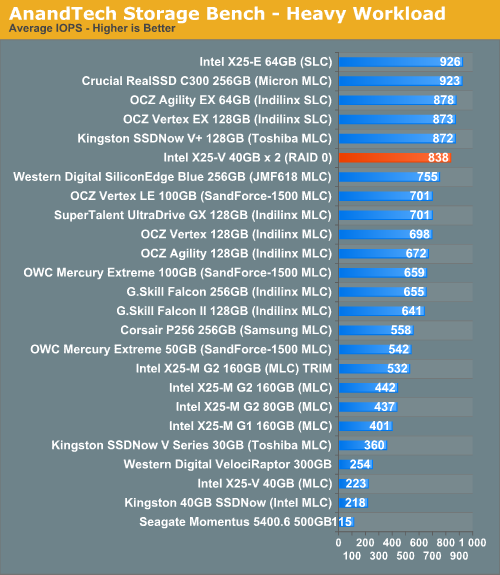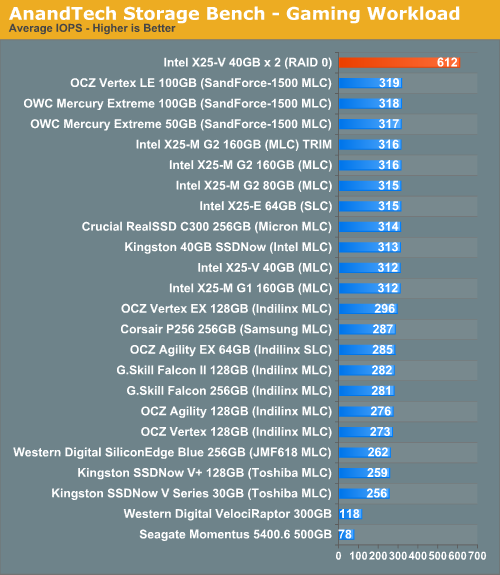Intel X25-V in RAID-0: Faster than X25-M G2 for $250?
by Anand Lal Shimpi on March 29, 2010 8:59 PM ESTAnandTech Storage Bench
The first in our benchmark suite is a light usage case. The Windows 7 system is loaded with Firefox, Office 2007 and Adobe Reader among other applications. With Firefox we browse web pages like Facebook, AnandTech, Digg and other sites. Outlook is also running and we use it to check emails, create and send a message with a PDF attachment. Adobe Reader is used to view some PDFs. Excel 2007 is used to create a spreadsheet, graphs and save the document. The same goes for Word 2007. We open and step through a presentation in PowerPoint 2007 received as an email attachment before saving it to the desktop. Finally we watch a bit of a Firefly episode in Windows Media Player 11.
There’s some level of multitasking going on here but it’s not unreasonable by any means. Generally the application tasks proceed linearly, with the exception of things like web browsing which may happen in between one of the other tasks.
The recording is played back on all of our drives here today. Remember that we’re isolating disk performance, all we’re doing is playing back every single disk access that happened in that ~5 minute period of usage. The light workload is composed of 37,501 reads and 20,268 writes. Over 30% of the IOs are 4KB, 11% are 16KB, 22% are 32KB and approximately 13% are 64KB in size. Less than 30% of the operations are absolutely sequential in nature. Average queue depth is 6.09 IOs.
The performance results are reported in average I/O Operations per Second (IOPS):

That's right. A pair of X25-Vs in RAID-0 offers better performance in our light workload than Crucial's RealSSD C300, a $799 drive. The performance scaling is more than perfect, but that's a side effect of the increase in capacity. Remember that Intel's controller uses any available space on the SSD as spare area to keep write amplification at a minimum. Our storage bench is based on a ~34GB image, which doesn't leave much room for the 40GB X25-V to keep write amplification under control. With two our total capacity is 74.5GB, which is more than enough for this short workload. With the capacity cap removed, the X25-Vs can scale very well. Not nearly twice the performance of an X25-M G2, but much faster than a single drive from Intel.
If there’s a light usage case there’s bound to be a heavy one. In this test we have Microsoft Security Essentials running in the background with real time virus scanning enabled. We also perform a quick scan in the middle of the test. Firefox, Outlook, Excel, Word and Powerpoint are all used the same as they were in the light test. We add Photoshop CS4 to the mix, opening a bunch of 12MP images, editing them, then saving them as highly compressed JPGs for web publishing. Windows 7’s picture viewer is used to view a bunch of pictures on the hard drive. We use 7-zip to create and extract .7z archives. Downloading is also prominently featured in our heavy test; we download large files from the Internet during portions of the benchmark, as well as use uTorrent to grab a couple of torrents. Some of the applications in use are installed during the benchmark, Windows updates are also installed. Towards the end of the test we launch World of Warcraft, play for a few minutes, then delete the folder. This test also takes into account all of the disk accesses that happen while the OS is booting.
The benchmark is 22 minutes long and it consists of 128,895 read operations and 72,411 write operations. Roughly 44% of all IOs were sequential. Approximately 30% of all accesses were 4KB in size, 12% were 16KB in size, 14% were 32KB and 20% were 64KB. Average queue depth was 3.59.

We see the same super scaling here thanks to the increase in capacity offered by RAIDing two of these drives together. The overall performance is great. We're at around 91% better performance than a single X25-M G2.
The gaming workload is made up of 75,206 read operations and only 4,592 write operations. Only 20% of the accesses are 4KB in size, nearly 40% are 64KB and 20% are 32KB. A whopping 69% of the IOs are sequential, meaning this is predominantly a sequential read benchmark. The average queue depth is 7.76 IOs.

As we saw in our sequential read tests, the X25-Vs in RAID-0 can do very well in sequential read workloads. Our game loading test has the X25-V RAID array beating even Crucial's 6Gbps RealSSD C300.










87 Comments
View All Comments
galvelan - Friday, April 2, 2010 - link
Looks forward to the info Annihilus.GullLars - Saturday, April 3, 2010 - link
Damn, that's a lot of RE:'sAnyways, i thought i'd post it here so everyone could see:
The numbers he's refering to shows 16KB stripe as superior performance-wise.
Here's the PCmark vantage HDD scores of 3 x25-V's in RAID-0 by stripe size:
16KB: 74 164
32KB: 70 364
64KB: 63 710
128KB: 55 045
For those wondering, 16KB shows 540MB/s read and 131MB/s write in CrystalDiskMark 3.0 while 128KB shows 520MB/s read and 131MB/s write (1000MB lenght, 5 runs)
Also, here are the AS SSD total scores by stripe size for 3 x25-V's in RAID-0:
16KB: 809
32KB: 797
64KB: 795
128KB: 774
By doing PCmark vantage points multiplied by 2/3, i guess Anand used a 128KB stripe.
If he'd used a 16KB stripe, the numbers would likely be around 48-49 000
This is supported by benchmarking done by the user Anvil, who got 47 980 points in the Vantage HDD test with 2 x25-V's in RAID-0 off ICH10R with a 16KB stripe size. (IRST 9.6 driver, writeback cache disabled).
galvelan - Friday, April 2, 2010 - link
Excellent info GullLars... Think others are just thinking that 128k is best for all SSD's.. But they obviously are not all the same.. Thanx alot!!mschira - Tuesday, March 30, 2010 - link
Hi I like to get two 160 25-M for RAID. Linux software RAID to be precise.Can I use TRIM then?
best
M.
yacoub - Tuesday, March 30, 2010 - link
"earlier this month Intel launched its first value SSD: the X25-V."Last month.
The drive was definitely available in early February. Maybe you started writing this article in February? :)
buzznut - Thursday, April 1, 2010 - link
bought mine in January.Lithium - Tuesday, March 30, 2010 - link
Great test Mr. Anand.
Few weeks ago I purchased two Kingston 40GB drives to do just that, RAID-0.
Can you please explain which program you use for Secure Erase and in which enviroment, from DOS or Windows.
Next, when you create smaller 60GB partition, from DOS or from Win7 setup. Should I use quick format from Win7 setup...
All the best
Thanks
7Enigma - Tuesday, March 30, 2010 - link
Hi Anand,It it really as simple as copying a large file(s) to the free space of these SSD's in RAID to bring performance back to similar to a secure erase?
If so why doesn't Intel or some other 3rd party release a small program that simply uses My Computers' free space measurement, copy a file of the same size to the SSD and then delete it? Seems like it could be done very easily.
Thanks for the mini-review....makes me want to get another 80gig G2 to RAID with my current one!
mervincm - Tuesday, March 30, 2010 - link
I think this app does exactly that. You can even pick if it writes )'s or 1'smervincm - Tuesday, March 30, 2010 - link
Freespacecleaner AS-Clean